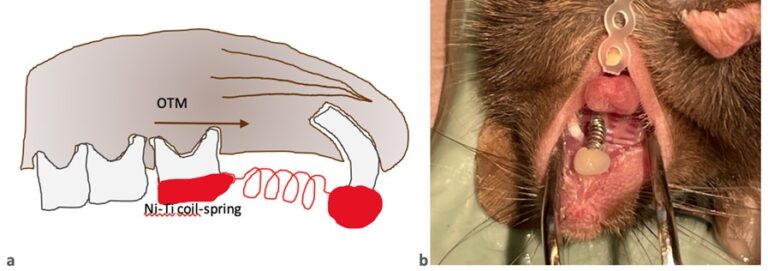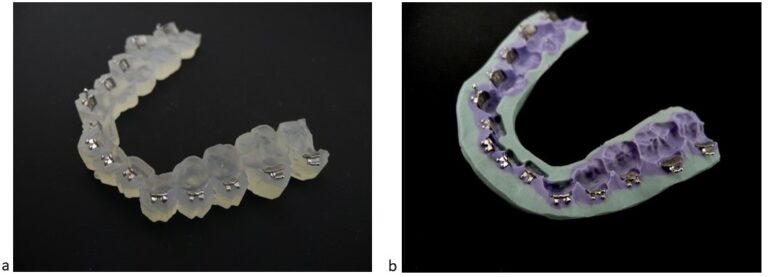
MUI
Anichstraße 35
6020 Innsbruck
Fax: +43 (0)50 504 27199
Email: Adriano.Crismani@i-med.ac.at
Website: https://www.i-med.ac.at/kieferorthopaedie/
Research year
Research Branch (ÖSTAT Classification)
104024, 211904, 301108, 302033, 302034, 302044, 302071, 302088
Keywords
dental anomalies, indirect bonding trays, Inflammasome, lateral incisors width, NLRP3, oral irrigator, orthodontic miniscrews, orthodontic tooth movement, surface-coated materials, and tooth agenesis
Research Focus
- The role of the NLRP3 inflammasome in orthodontic tooth movement (OTM).
- Evaluation of osseointegration of loaded strontium-functionalized orthodontic mini screws (Ti-Sr-O).
- Evaluation of the standard value of the lateral incisors in the upper jaw in Tyrol.
- Comparison of two home interdental oral hygiene products.
- Transfer accuracy of silicone- vs. 3D-printed trays.
- Lip pressure before, during and after orthodontic treatment.
General Facts
The University Hospital for Orthodontics is part of the Department of Dental and Oral Medicine and Cranio-Maxillofacial and Oral Surgery. There is no extra laboratory staff. The major aims of our basic and clinical research on orthodontics are to increase our understanding of the field and to optimize patient treatment. Our current research focuses on the role of the NLRP3 inflammasome in orthodontic tooth movement (OTM), on strontium-functionalised orthodontic mini screws, on the standard value of the lateral incisors in the upper jaw and on interdental oral hygiene in orthodontic patients. We are also studying the bone quality upon orthodontic tooth movement, analysing the oral microbiome, comparing the transfer accuracy of indirect bonding using 3D-printed trays and silicone trays and investigating the lip pressure in orthodontically treated patients. We collaborate closely with a number of clinical and scientific units at the Medical University of Innsbruck and with international research partners. We have particularly close collaborations on the Innsbruck campus with the University Hospital for Restorative Dentistry and Periodontology, the University Hospital for Cranio-Maxillofacial and Oral Surgery, the University Hospital for Radiology and the Institute of Pathology and Molecular Pathology.
Research
The NLRP3 inflammasome and orthodontic tooth movement – a mouse model
Lisa Schieffer et al.
We are investigating the role of the NLRP3 inflammasome in orthodontic tooth movement (OTM), aiming to shed light on the processes involved in bone transformation upon orthodontic treatment. We hope to clarify the effects of tooth movement on inflammatory pathways, with special emphasis on the expression of pro-inflammatory cytokines. There is evidence of a negative co-regulation between physiological estrogen levels and the speed of OTM, so we are also evaluating gender differences.
We used NLRP3-depleted mice (NLRP3-/-) and wild-type littermates (WT; males and females) in a model of experimental OTM induced by nitinol coil-springs bonded between the left first maxillary molar and the upper incisors (Fig. 1). Teeth in the right maxillae served as contralateral controls. After 7, 14 and 21 days of constant orthodontic force, mice were sacrificed and the jaws removed and analysed by micro-computed tomography (distance for mesial movement of the first molar was measured) and histologically (TRAP staining). To monitor the onset of the inflammasome upon OTM, we measured the levels of IL-1β in blood plasma by enzyme-linked immunosorbent assay (ELISA). We also analysed general health parameters (blood, bodyweight).
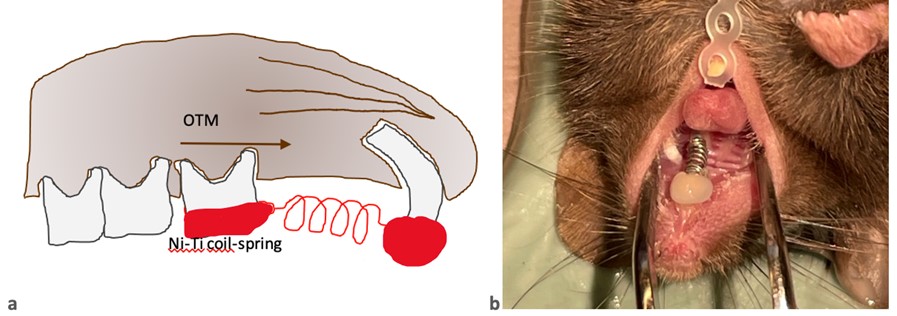
We used micro-computed tomography to show that the tooth movement was less in NLRP3-/- mice than in their WT littermates. Female mice showed less OTM than WT male mice. TRAP staining showed statistically significantly more osteoclasts in WT mice than in the NLRP3-/- mice. There were low serum levels of IL-1β in all mice, indicating that there was no systematically detectable inflammation. The analysis of the weight and the blood parameters showed that the mice were in good general health and of sufficient nutritional status.
Our experiments on orthodontic tooth movement in NLRP3-/- mice showed that the NLRP3 inflammasome is involved in osteoclast induction at the alveolar bone surface on the compression side. This suggests that NLRP3 has a mechanosensory role in OTM. The results also point to a negative co-regulation of female hormones in molecular pathways of tooth movement. We are still waiting for the results of additional tests, such as bone quality, FACS analysis and the analysis of the oral microbiome.
Lip pressure before, during and after orthodontic treatment. A pilot study
Hanna Gänzer et al.
We are investigating whether fixed orthodontic appliances have an influence on musculature and in turn on oral posture. Our study participants will be drawn from the patients of the University Department of Orthodontics who are scheduled for treatment with fixed orthodontic appliances. We will measure lip pressure with a myofunctional therapy (MFT) lip scale before the start of treatment, on the day braces are fitted and after three months. We do not expect a significant difference in lip pressure before or during orthodontic treatment. If we find a change in lip pressure, we will undertake further studies to investigate whether the change returns to normal after treatment and to what extent it affects the position of the teeth. In this case, we would recommend more frequent prophylaxis for patients with fixed orthodontic appliances to counteract the development of gingivitis and periodontitis due to the open mouth.
The normal width of lateral incisors in the maxilla in a European population.
Irene Artioli et al.
Dental anomalies are clinical alterations that originate during the process of tooth formation. We are undertaking a prospective study to establish the normal and hypoplasia values for maxillary lateral incisors. We are also aiming to describe the relationship between the width of the lateral and the central incisors, considering gender, age and body height.
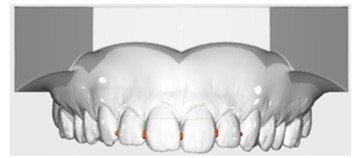
We can tentatively draw the following conclusions for a European population:
1. A hypoplasia of the maxillary lateral incisor can be defined for teeth with a mesiodistal width less than 6.18 mm;
2. The mesiodistal width of the maxillary lateral incisor is given by the formula: y = 1.88 + 0.55 ∗ x
3. Men have bigger teeth than women.
4. The taller the person, the bigger the teeth.
Clinical comparison of two home interdental oral hygiene products in adolescent orthodontic patients
Hanna Gänzer, Manuel Kasslatter et al.
Orthodontic patients struggle with interdental cleaning, so there is a need for simpler mechanical devices to reduce the high plaque levels. We used a randomized and single-blinded cross-over study to compare the cleansing efficacy of an oral irrigator with that of dental flossing in patients with fixed braces after four weeks of home use. After twenty-eight days of using the products at home, we compared hygiene indexes (Rustogi Modified Navy Plaque Index (RMNPI); Gingival bleeding index (GBI) between participants who used the test product (oral irrigator) or those using a control product (dental floss). Seventeen adult individuals finalized the study. After 28 days of cleaning with the oral irrigator, the RMNPI was 54.96 % (46.91 – 66.05) compared to 52.98 % (42.75 – 65.60) with dental floss (p = 0.029). A subgroup analysis revealed that the higher cleansing efficacy of the dental floss is attributable to the buccal and marginal areas. GBI after the test phase with the oral irrigator was 12.96 % (7.14 – 24.31) and significantly higher than 8.33 % (5.84 – 15.33) with dental floss (p = 0.030), a result seen in all subgroups.
The study showed that oral irrigators do not remove plaque or reduce gingival bleeding as efficiently as dental floss in easily accessible regions. However, the oral irrigator showed similar results to dental floss in posterior regions, where the patients struggled with the application of dental floss. In conclusion, oral irrigators should only be recommended to orthodontic patients who are not compliant with dental flossing and for whom interdental brushes are not applicable.
Transfer accuracy of silicone and 3D-printed trays for indirect bonding of orthodontic brackets
Irene Artioli et al.
The ideal positioning of brackets is one of the most time-consuming procedures in orthodontics and an incorrect bracket location can lead to unplanned tooth movements. Nowadays, the digital indirect bonding technique makes it possible to place the brackets on digital models and print the transfer tray without a physical model. We have compared the transfer accuracy between digitally planned bracket positions of additively manufactured trays (ADT) and polyvinyl-siloxane trays (PST). We also made a comparison between practitioners. We found that ADT and PST are both valid methods for the indirect bonding of orthodontic brackets. The transfer accuracy of ADT and PST is not determined by the experience of the practitioner. Transfer accuracy is highest for the incisors, followed by the premolars, canines and molars.
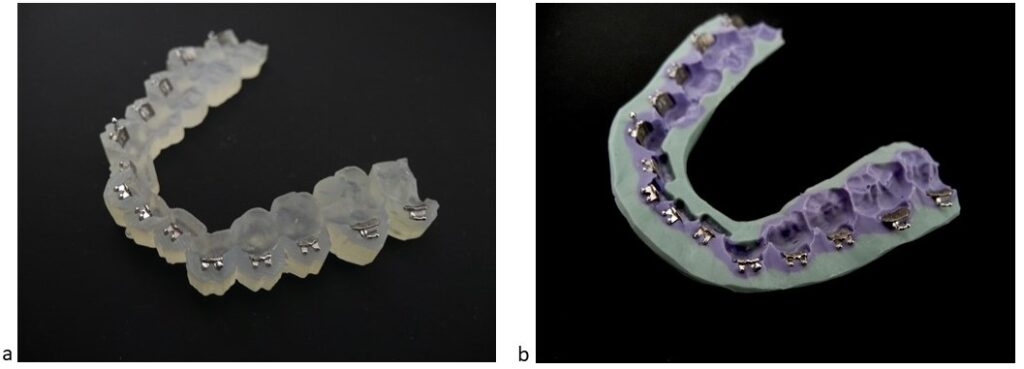
Pictures
Selected Publications
Artioli I, Ndayisaba A, Ndayisaba JP, Crismani AG. The normal width of the lateral incisors in the maxilla in an European population. CLIN ORAL INVESTIG: 2025; 29: 159
Natalie Schenz-Spisic , Thorbjørn E.K. Christensen , Jonas Palle , Maja Østergaard , Maiken Berglund , Johannes Hubner , Hannes Huber , Irene Artioli , Vincent Offermanns , Chunying Chen , Morten Foss , Adriano G. Crismani , Henrik Birkedal. Strontium-coating of orthodontic miniscrews provides higher osseointegration – a rat model studied by histology, synchrotron X-ray fluorescence and diffraction imaging. MATERIALIA: 2025; https://doi.org/10.1016/j.mtla.2025.102385
Gänzer H, Kasslatter M, Wiesmüller V, Denk L, Sigwart AM, Crismani A. Cleansing efficacy of an oral irrigator with microburst technology in adolescent orthodontic patients. A randomized-controlled crossover study. CLIN ORAL INVESTIG: 2024; 28: 524
Selection of Funding
Austrian Society of Orthodontics for supporting the research activities at the University Clinic of Orthodontics
Tiroler Wissenschaftsförderung (TWF) Dr Lisa Schieffer MSc. for the project: ”The NLRP3 Inflammasome and Orthodontic Tooth Movement“
Collaborations
Foss M, Interdisciplinary Nanoscience Center (iNANO), Aarhus University, Aarhus, Denmark
Clinical Department of Neurology, Medical University of Innsbruck, Austria
